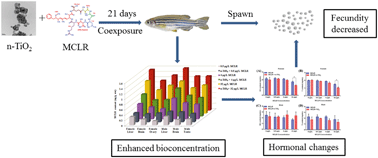Adverse reproductive performance in zebrafish with increased bioconcentration of microcystin-LR in the presence of titanium dioxide nanoparticles†
Abstract
The aim of the present study was to investigate the reproductive effects of microcystin-LR (MCLR) in the presence of titanium dioxide nanoparticles (n-TiO2). Five-month-old zebrafish were exposed to MCLR (0, 0.5, 4 and 32 μg L−1) alone or combined with n-TiO2 (100 μg L−1) for 21 days. The accumulation of both n-TiO2 and MCLR was observed in the fish liver, brain and gonad. Enhanced bioconcentration of MCLR was measured in coexposure groups. Joint exposure to both n-TiO2 and MCLR significantly reduced the fecundity of adult fish compared to the MCLR-only treatment. Histopathological examination revealed no obvious change in the morphology of the ovary and testis, while a significant decline of estradiol (E2) and testosterone (T) levels as well as disordered transcription patterns of genes along the hypothalamus–pituitary–gonadal (HPG) axis was observed. N-TiO2 may act as a carrier of MCLR and increase its concentration upon coming in contact with zebrafish, which exacerbated the reproductive endocrine dysfunction as a consequence.



 Please wait while we load your content...
Please wait while we load your content...